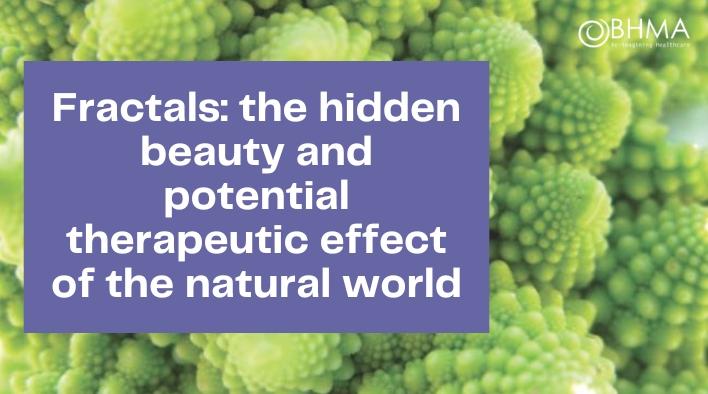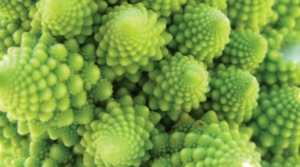Fractals: the hidden beauty and potential therapeutic effect of the natural world
Lucy Loveday, GP; Associate Research Fellow University of Exeter; Training Programme Director, Torbay; Regional Director, The British Society of Lifestyle Medicine
Published in JHH16.1 – Nature Connections
I live on Dartmoor with my young family and I am married to a physicist. This combination lends itself perfectly to a predilection for the natural world! While intuitively I know that being in nature makes me feel better, I am becoming increasingly interested in the scientific evidence base that supports this sentiment and the potential to apply this in a therapeutic context. I have always appreciated the intricate beauty that exists in nature and often pause to stare at tiny seashells when walking along the beach. Recently, I have been asking myself why exactly this pastime confers such a sense of calm? Is there any science behind these natural fractals? Curious to learn more, I have started to explore this subject further. In our increasingly technology-dependent world, I believe we have an innate need to reconnect with nature and experience for ourselves the benefits this can have on our health and wellbeing.
In 1975, polish-born maverick mathematician Benoit Mandelbrot discovered the fractal (Mandelbrot, 1982). A fractal object features a repetitive pattern, recurring on a progressively finer scale to create shapes of enormous complexity. Fractals can be found in abundance in nature and examples include pine cones, romanesco broccoli, trees, sea shells, ferns, peacock feathers, pineapples and clouds. The D-value assigned to a fractal is an important parameter to be aware of. It is used to denote a fractal pattern’s visual complexity. The D-value lies between 1 and 2. The closer the D value is to 2, the higher the extent to which the fine structure features in the fractal mix of repetitious patterns, resulting in a shape full of intricacy and detail. To the contrary, fractals with lower D-value reflect a smaller content of fine structure resulting in shapes that are more smooth and sparse in appearance (Taylor and Sprott, 2008).
Background
In 1981, Ulrich (1981) examined how scenes of nature influenced brain activity and stress physiology. He found that viewing scenes of nature (featuring water and vegetation) was associated with higher alpha wave amplitudes, which has been identified as indicative of a wakefully relaxed state (Laufs et al, 2003). Higher alpha wave activity is also associated with increased serotonin production, a chemical and neurotransmitter that operates within the nervous system, believed to play a role in regulation of mood.
D-value and the neurophysiological response to fractals
As well as being aesthetically pleasing, fractals have the capacity to lower stress, by affecting human physiology. This body of pioneering research has largely emerged over the past 15 years.
Taylor et al (2005) have demonstrated that experiencing mid-range D-value fractals has the potential to positively affect human stress levels by favourably altering human neurophysiology. In collaboration with neuroscientists and psychologists, Professor Taylor has successfully managed to objectively measure people’s responses to fractals found in art and nature by using photographic images of natural scenes in his studies. Initially, skin conductance measurements were used as these had previously been found to be a reliable indicator of mental performance stress, with higher conductance occurring during higher stress (Ulrich and Simons, 1986). Taylor et al monitored 24 participants carrying out a sequence of three intentionally stress-inducing mental tasks. During the tasks, the participants observed different fractal images comprising a range of D-values. The results showed that the smallest rise in stress occurred when the participants were observing an image of savannah, reported to have a fractal pattern with a mid-range D value of 1.4. This preliminary study highlighted the importance of the fractal dimension (D-value) when considering the potential for stress reduction by incorporating natural images into artificial environments. Naturalness alone is not sufficient. To develop this theory further, another study used continuous EEG (electro – encephalogram) monitoring to quantify participants’ neurophysiological response to visualising computer-generated images of landscape silhouettes with different D-values. Results demonstrated a significant difference in alpha response activity in the frontal area of the brain. The highest response occurred with the silhouette that possessed a mid-range D value of 1.32 (Taylor et al, 2011).
The conceptual model of nature therapy begins with a stressed state at the top and specifically alludes to the restorative effects of nature in its conclusion, while simultaneously acknowledging the individual differences and the need to incorporate evidence based medicine before concluding the preventative medical effects. The emerging empirical data that mid-range fractals have positive effects on human stress levels could be applied to the conceptual model of nature therapy as a potentially accessible lifestyle solution for stress that requires further exploration.
Research on natural fractals remains limited. There is great potential to build on this work and it would seem logical to build on existing research by incorporating more realistic forms of fractal stimuli as found in nature, perhaps using virtual reality to do so.
References
- Laufs H, Krakow K, Sterzer P, Eger E, Beyerle A, Salek-Haddadi A, Kleinschmidt A (2003) Electroencephalographic signatures of attentional and cognitive default modes in spontaneous brain activity fluctuations at rest. Proceedings of the National Academy of Sciences of the United States of America 100 (19) 11053–11058.
- Mandelbrot B (1982) The fractal geometry of nature. San Francisco, CA: WH Freeman.
- Miyazaki Y, Song C, Ikei H (2015) Preventive medical effects of nature therapy and their individual differences. Japanese Journal of Physiological Anthropology 20, 19–32.
- Taylor RP, Spehar B, Van Donkelaar P, Hagerhall CM (2011) Perceptual and physiological responses to Jackson Pollock’s fractals. Frontiers in Human Neuroscience 5 (60) 1–13.
- Taylor RP, Spehar B, Wise JA, Clifford CWG, Newell BR and Martin TP (2005) Perceptual and physiological responses to the visual complexity of Pollock’s dripped fractal patterns. Nonlinear Dynamics Psychology and Life Sciences 9 (1) 89–114
- Taylor RP, Sprott JC (2008) Biophilic fractals and the visual journey of organic screen-savers. Nonlinear Dynamics, Psychology and Life Sciences 12, 117–129.
- Ulrich RS (1981) Natural versus urban scenes: some psychophysiological effects. Environmental Behaviour 13, 523–556.
- Ulrich RS, Simons RF (1986) Recovery from stress during exposure to everyday outdoor environments. Proceedings of EDRA 17, 115–122.








